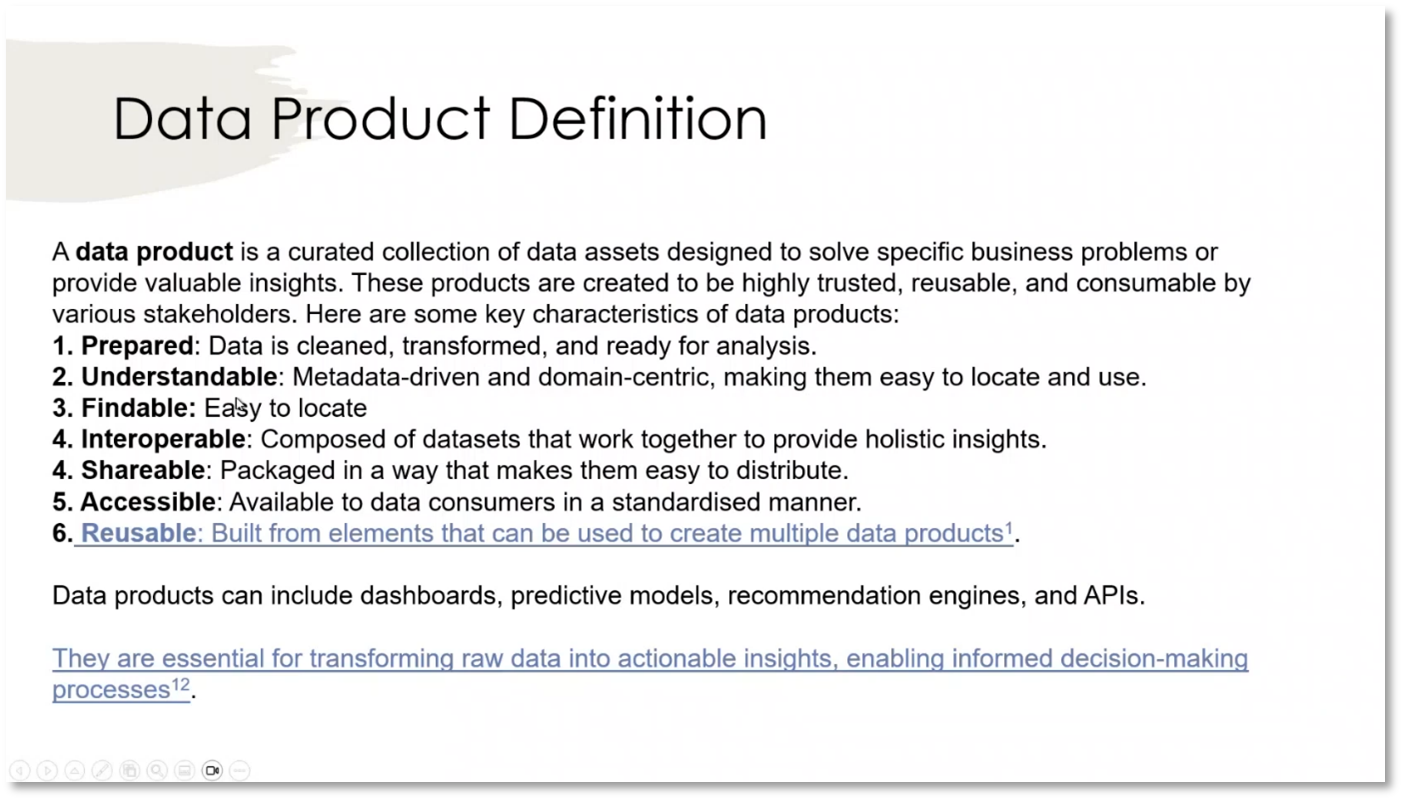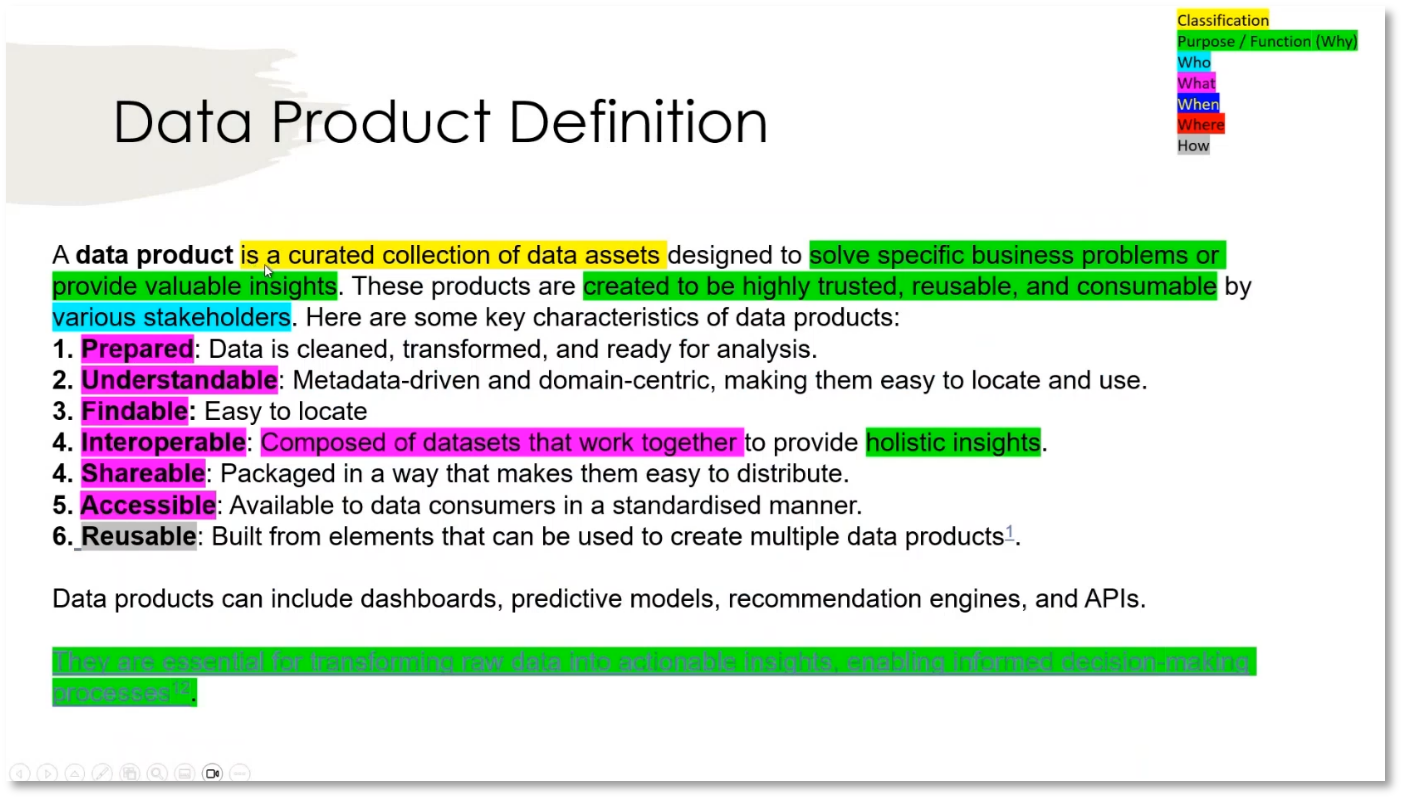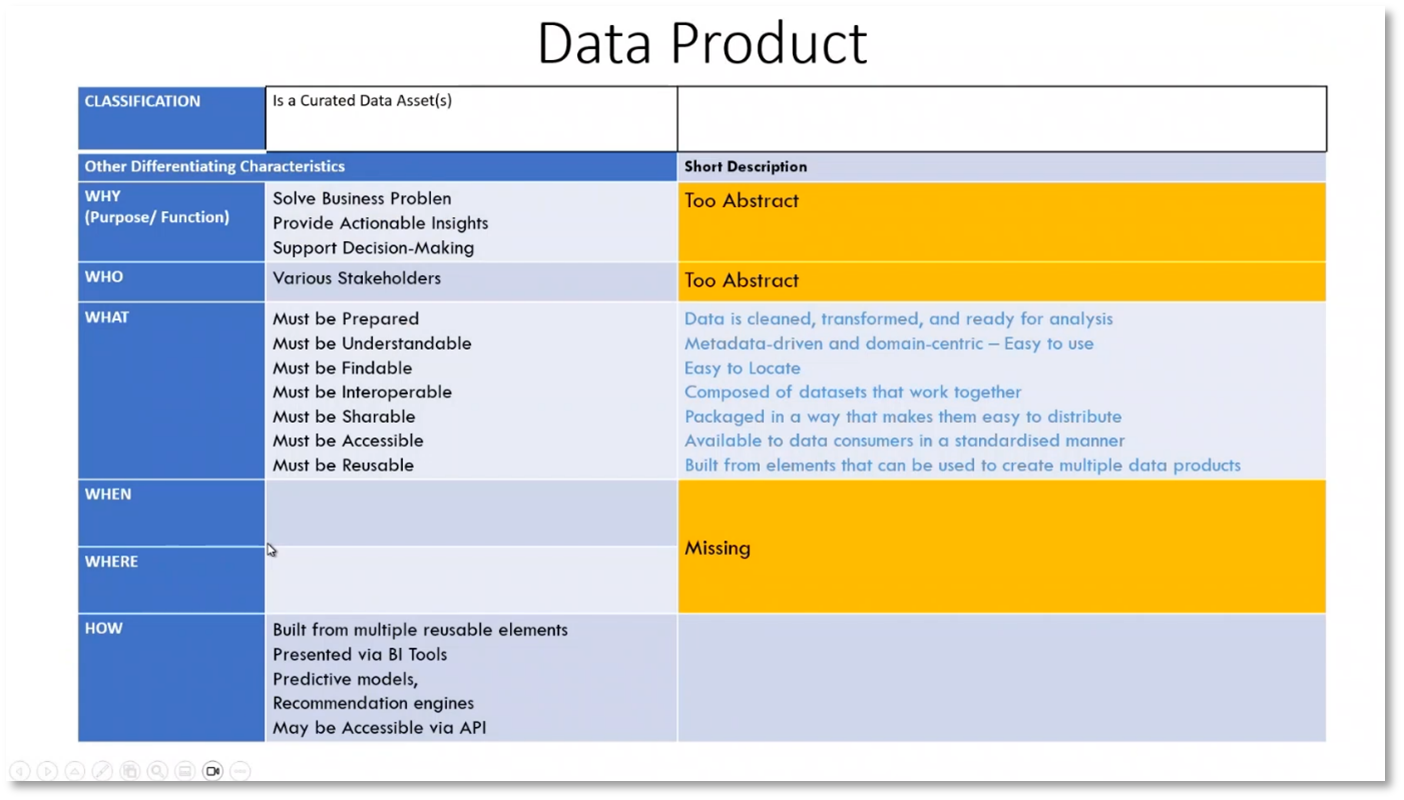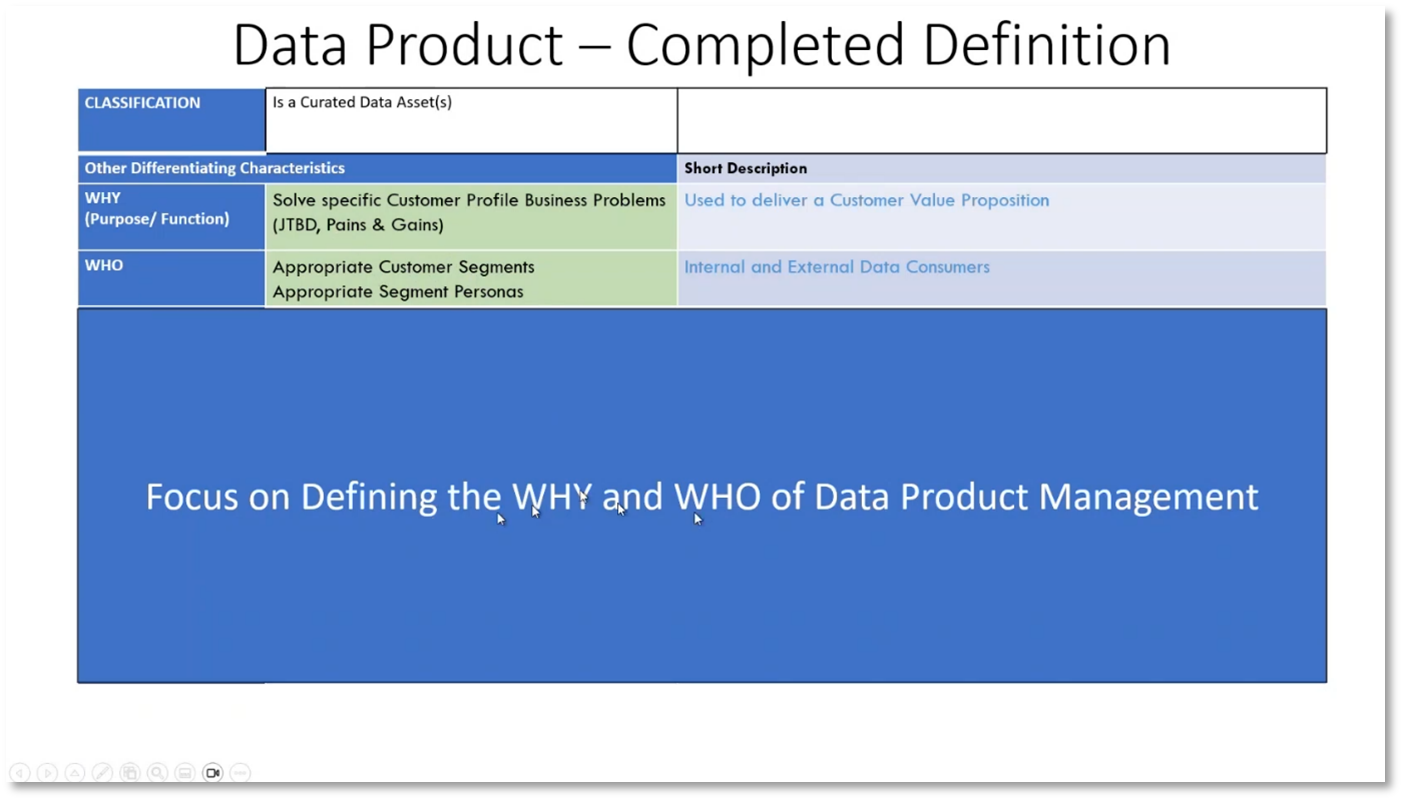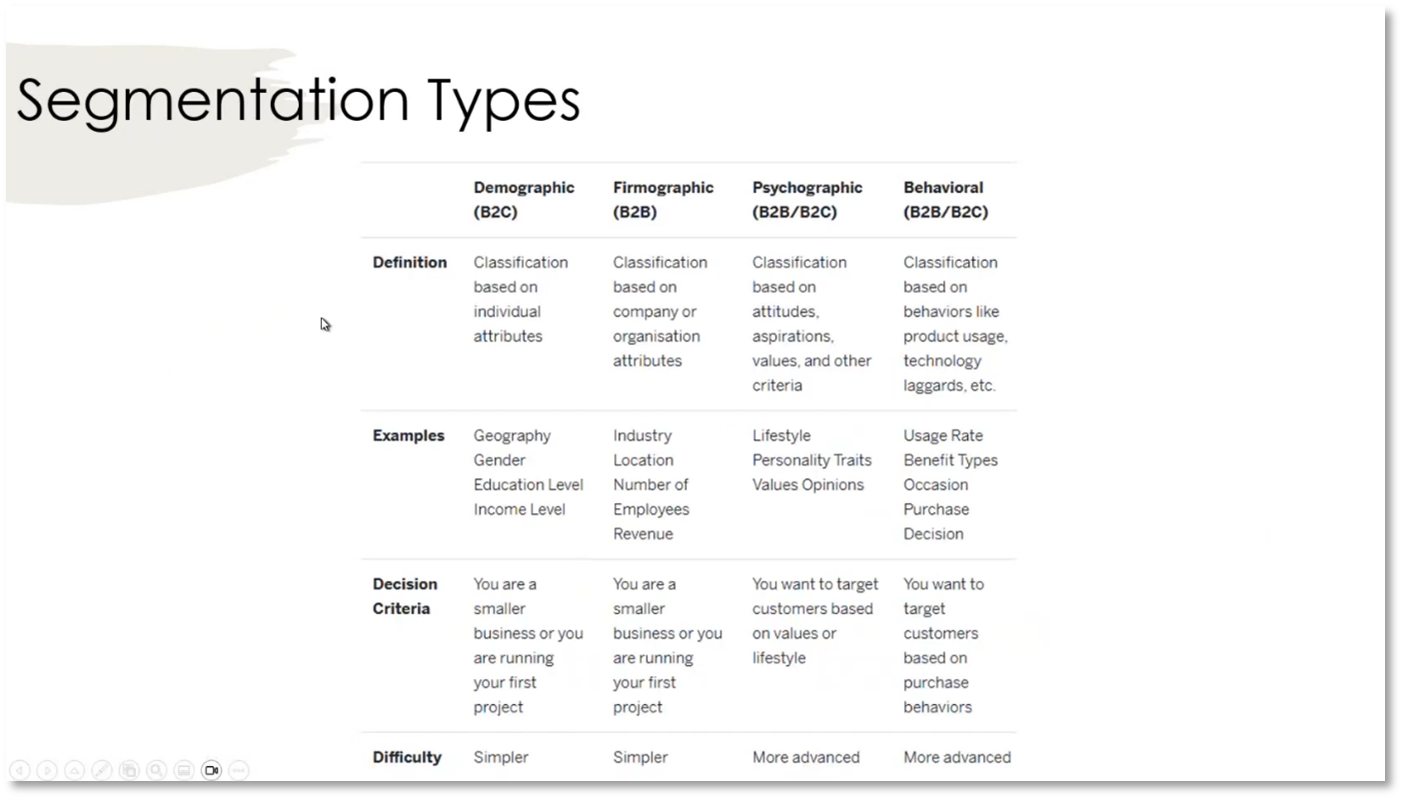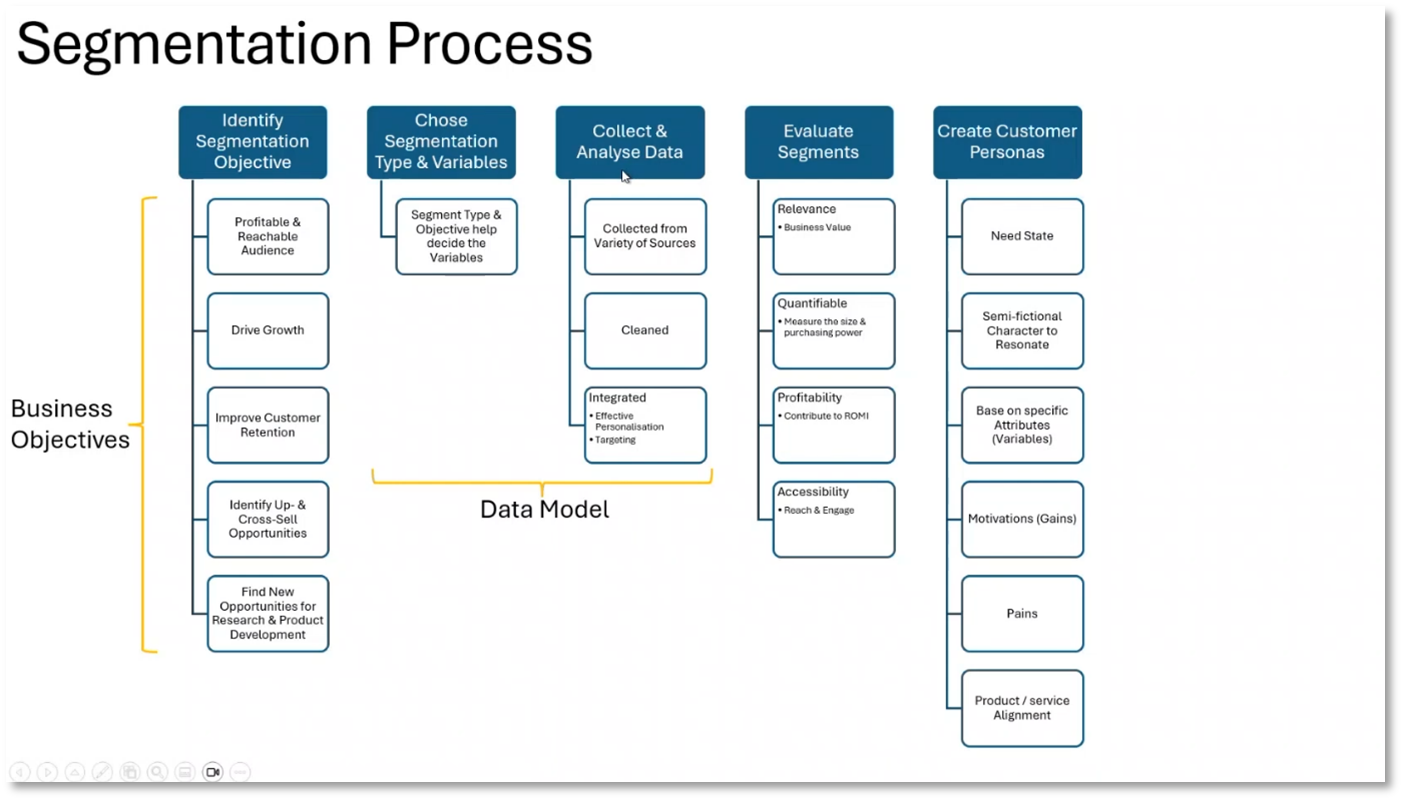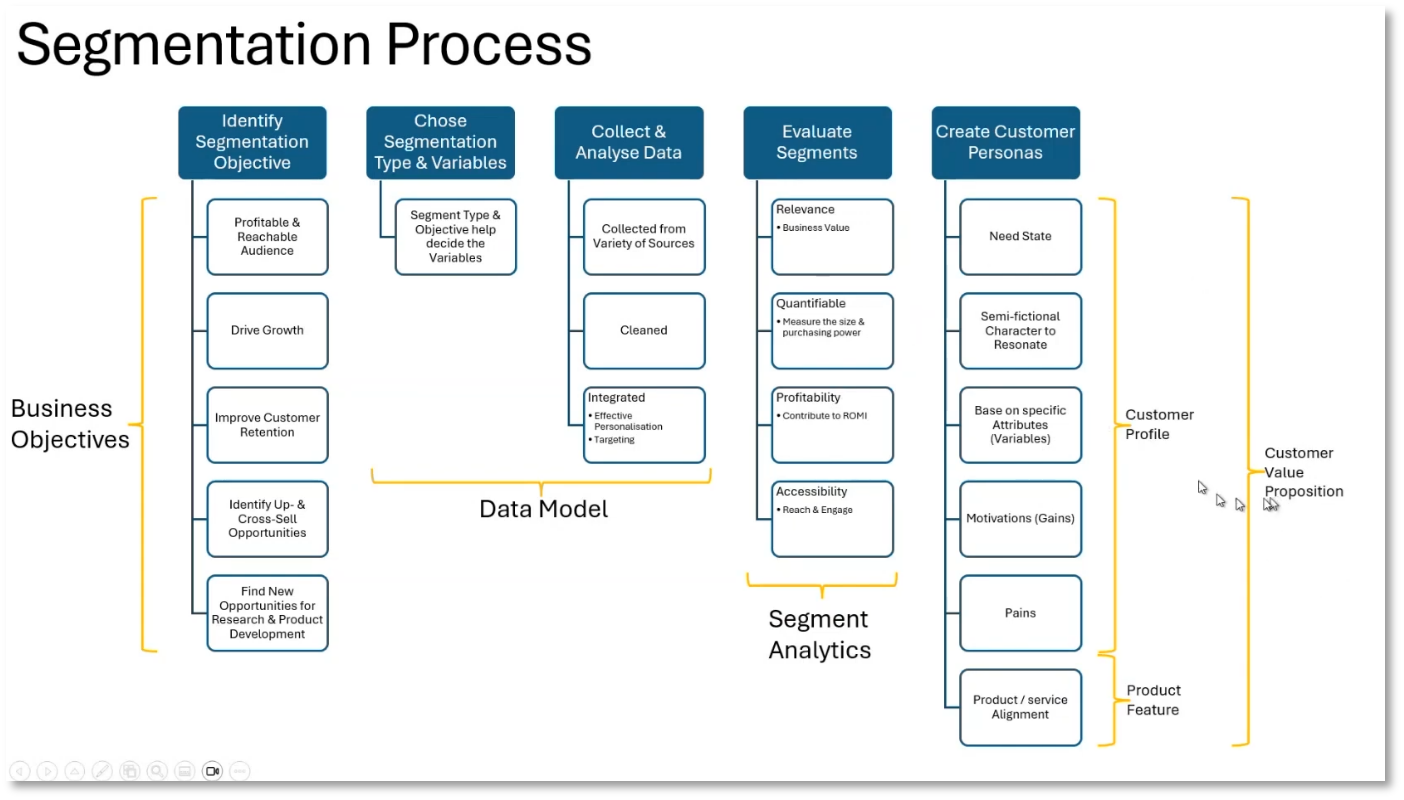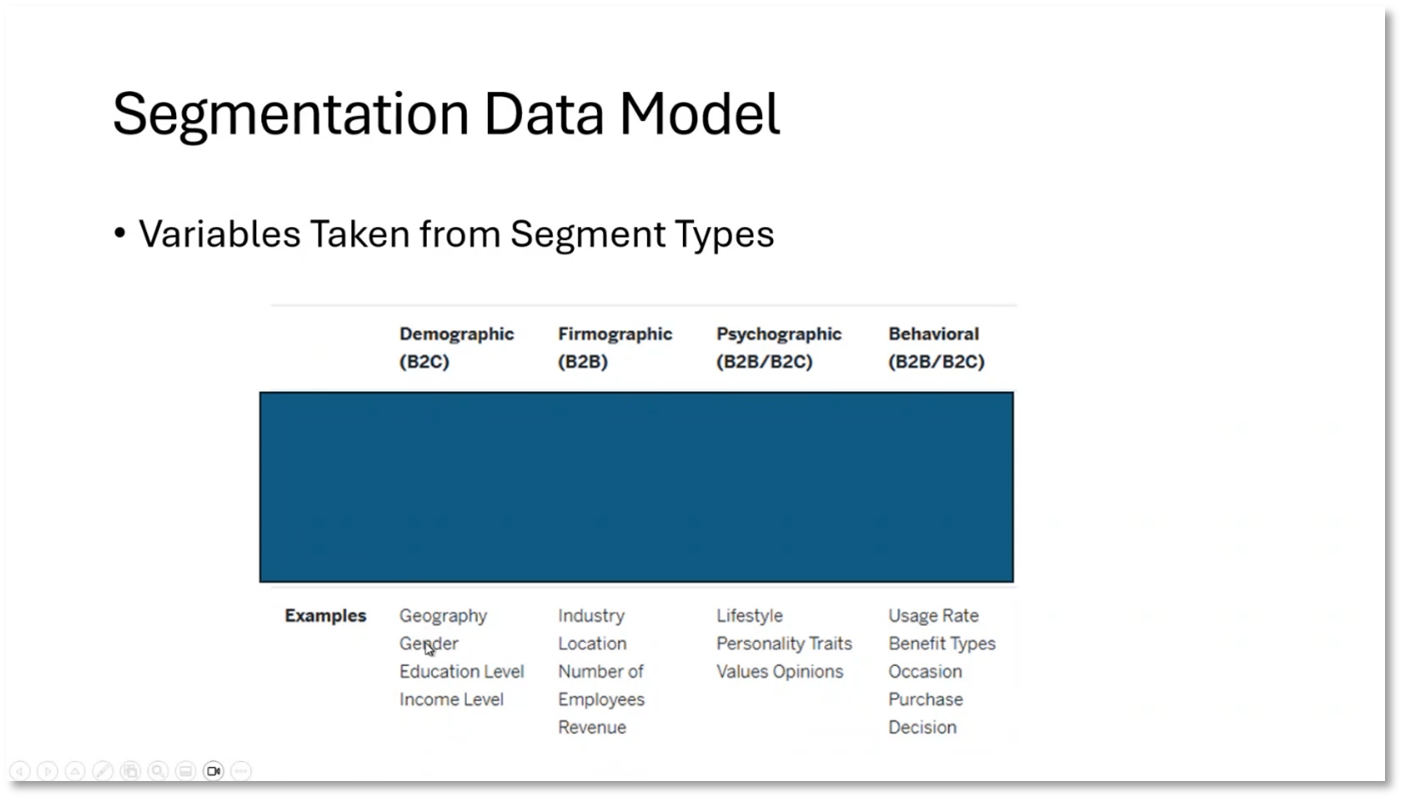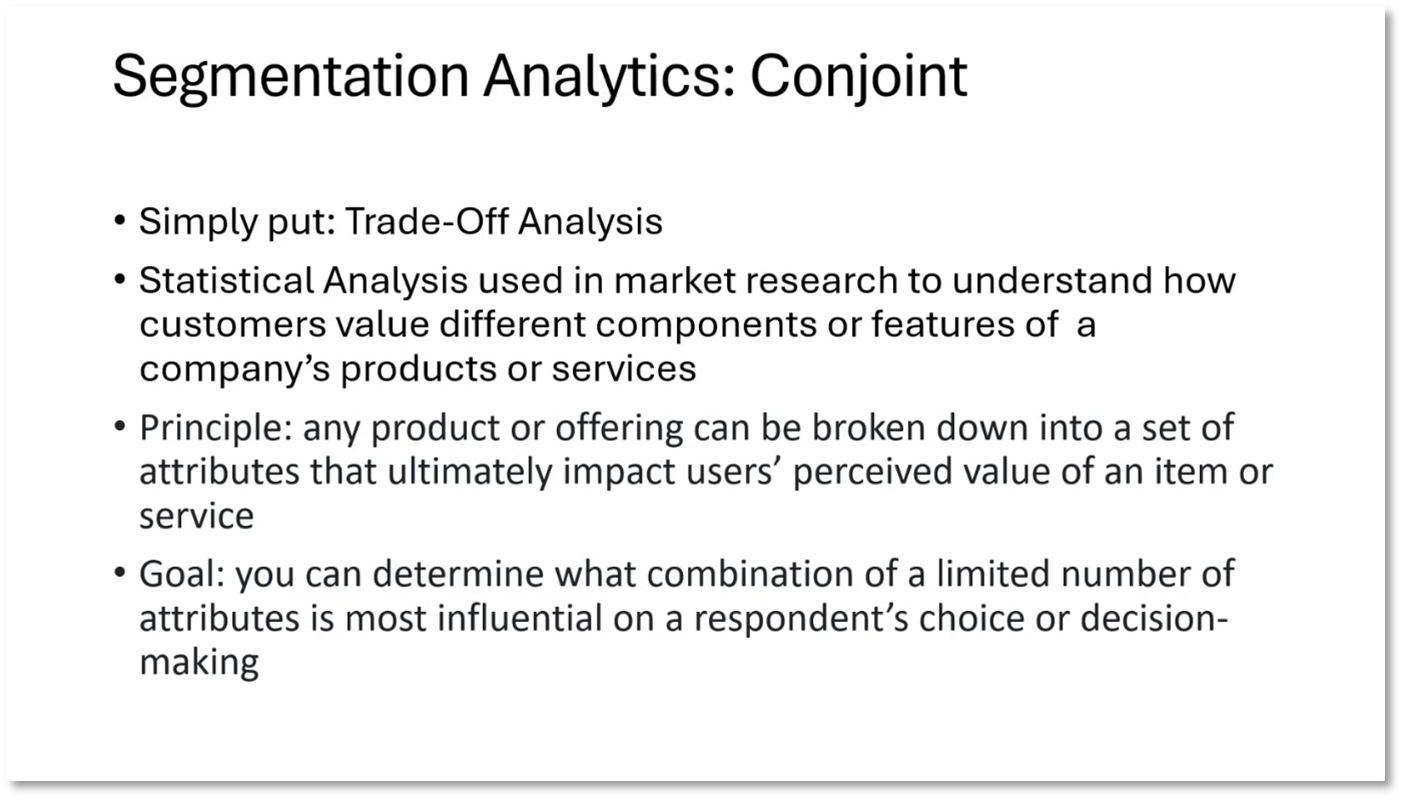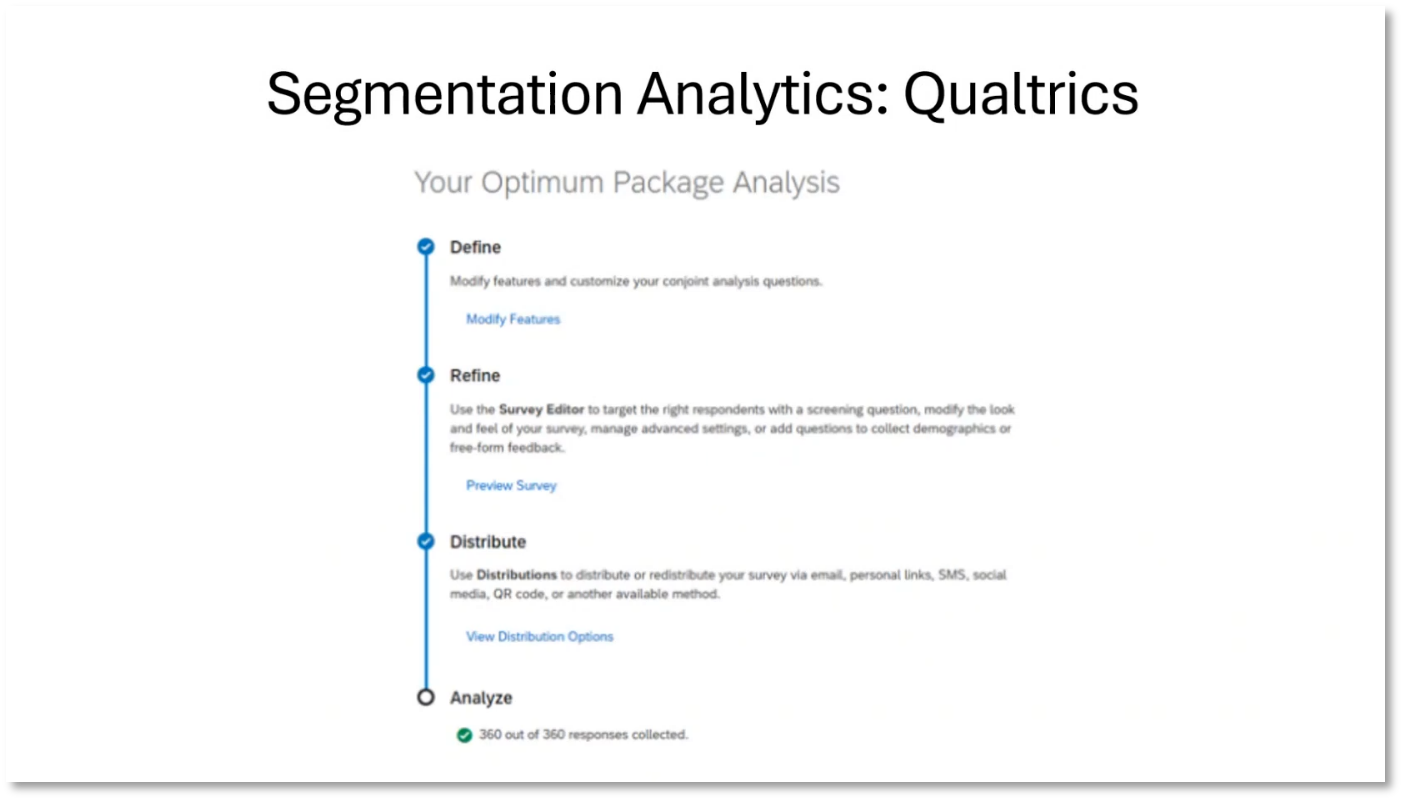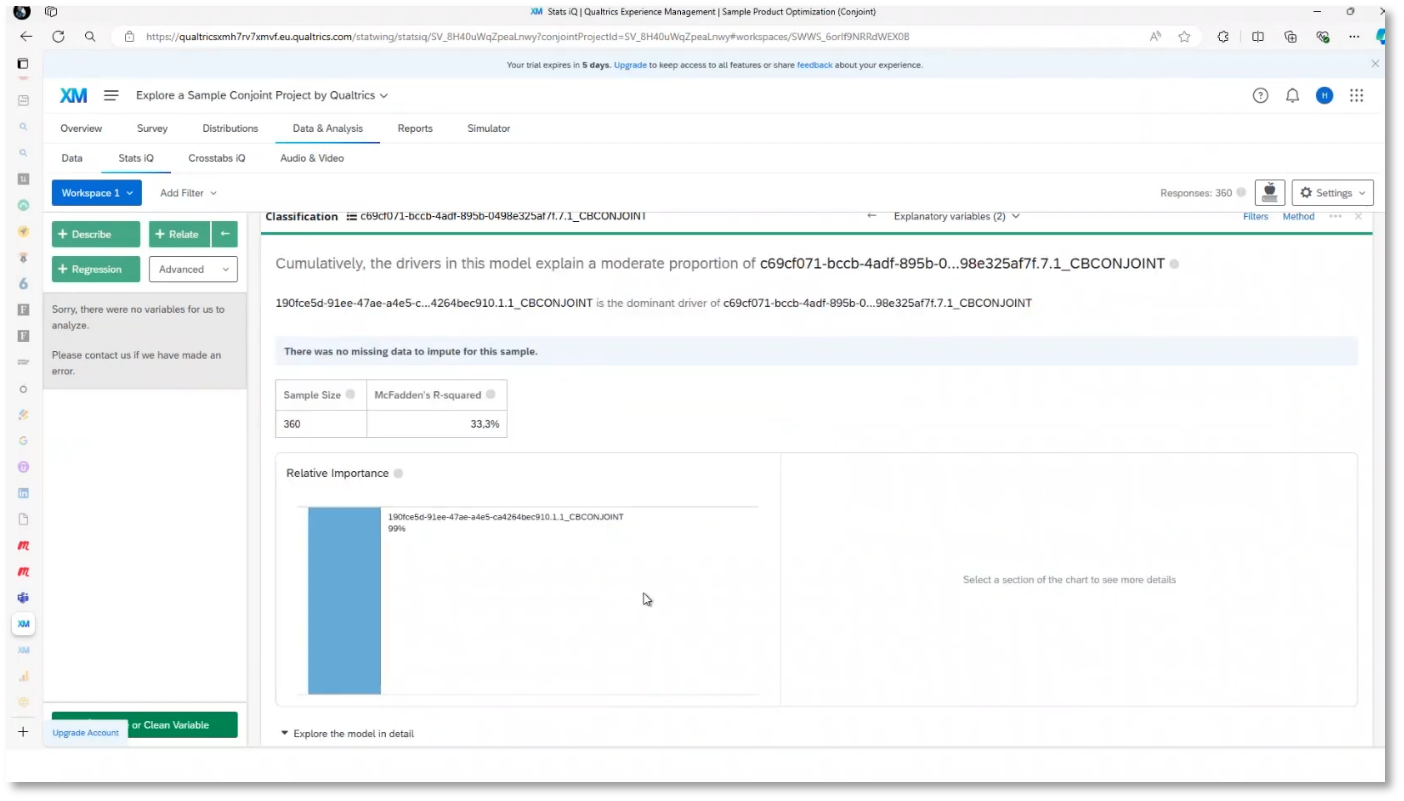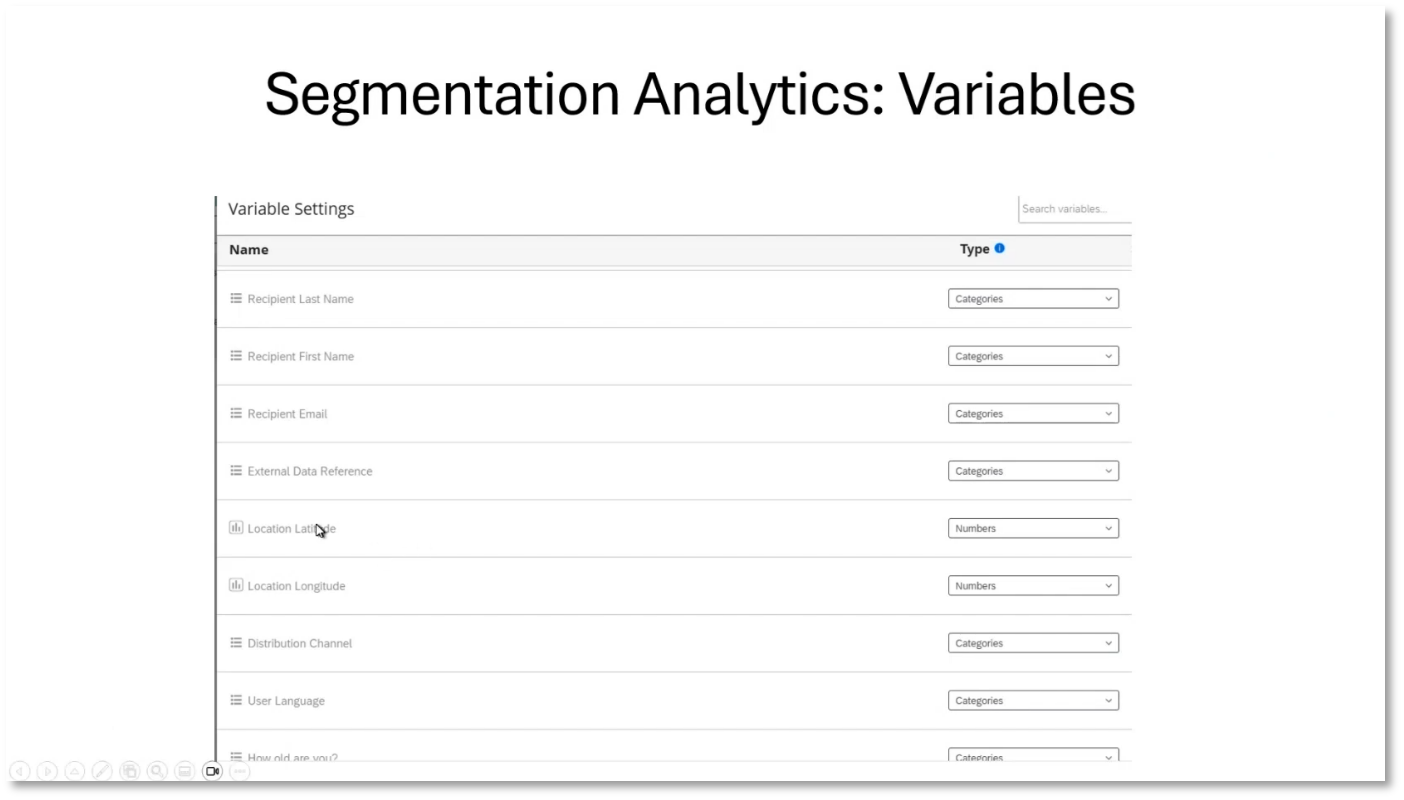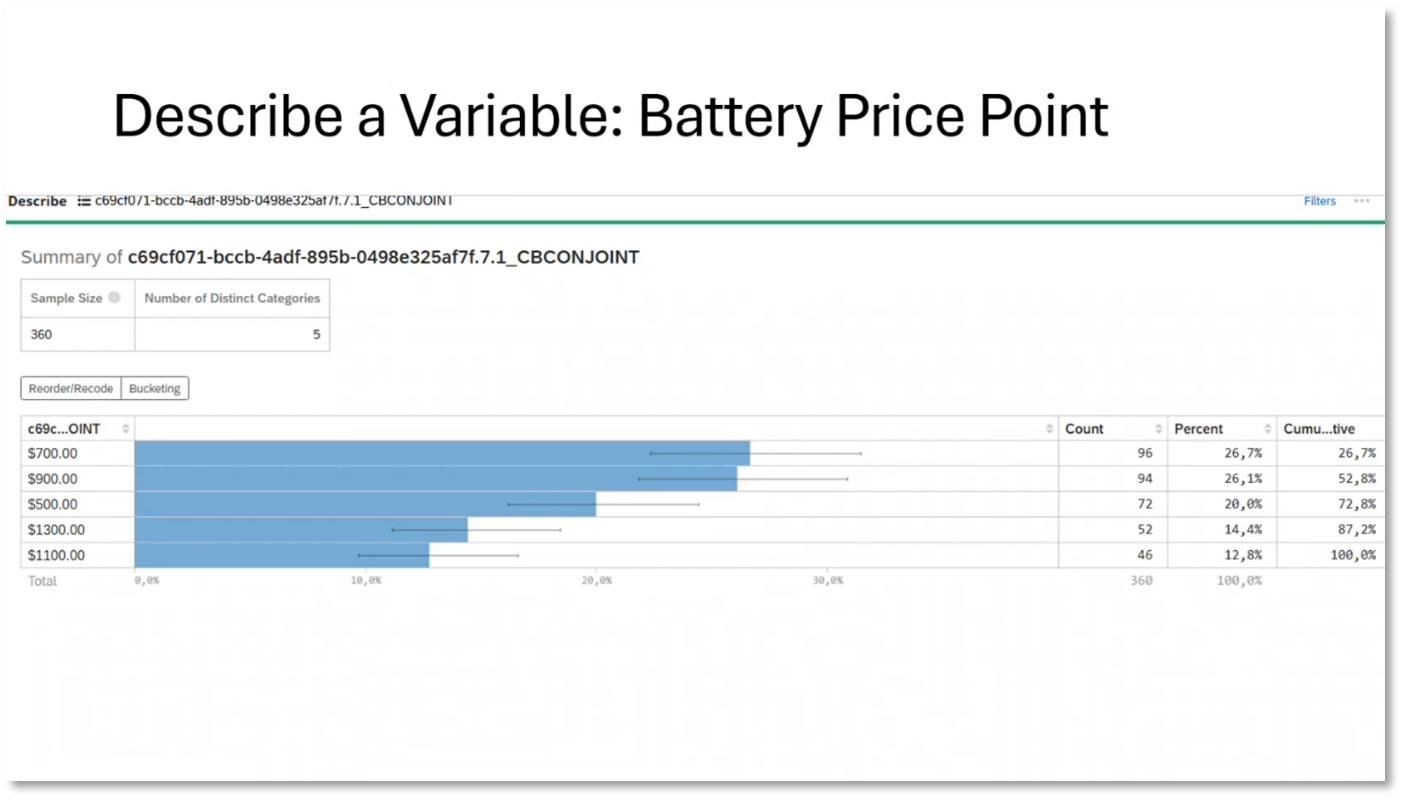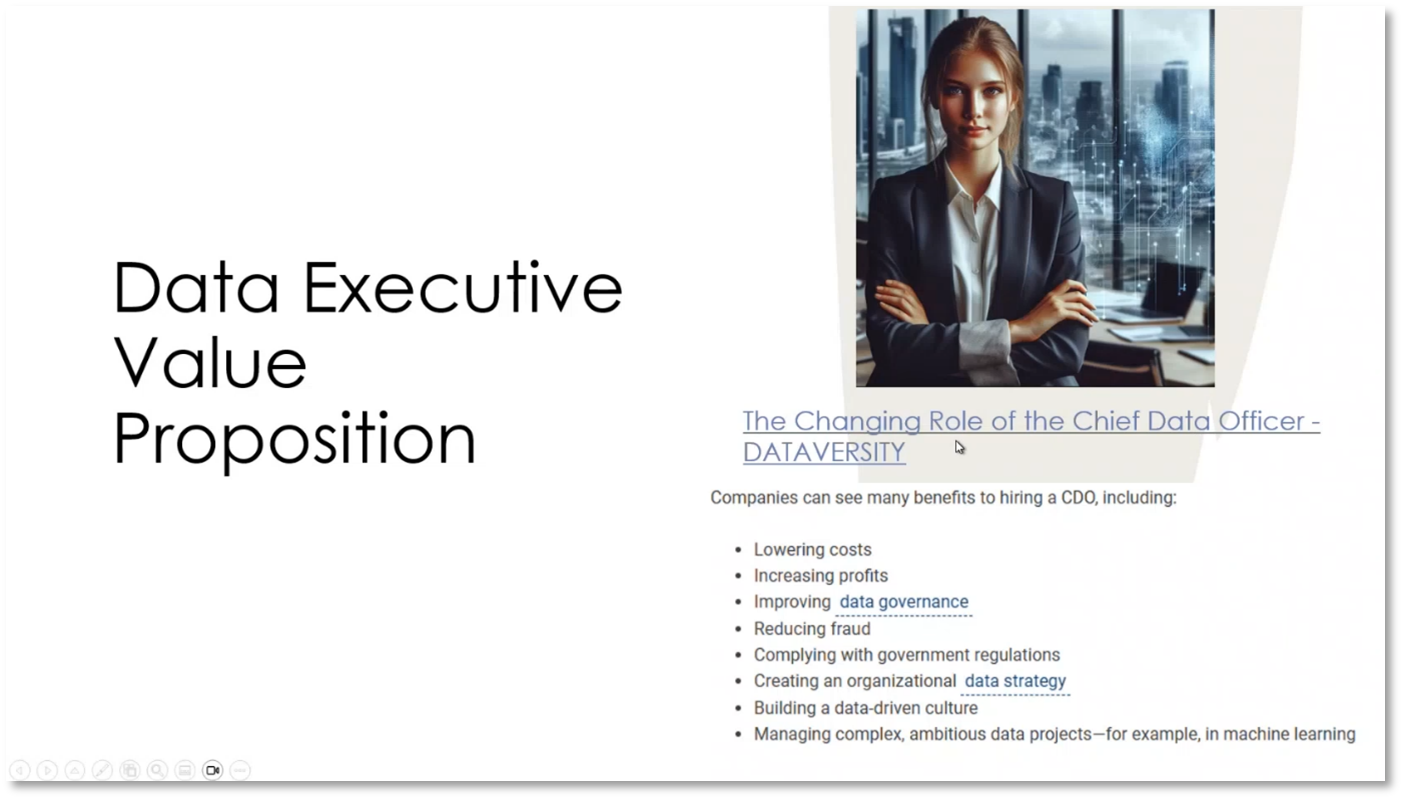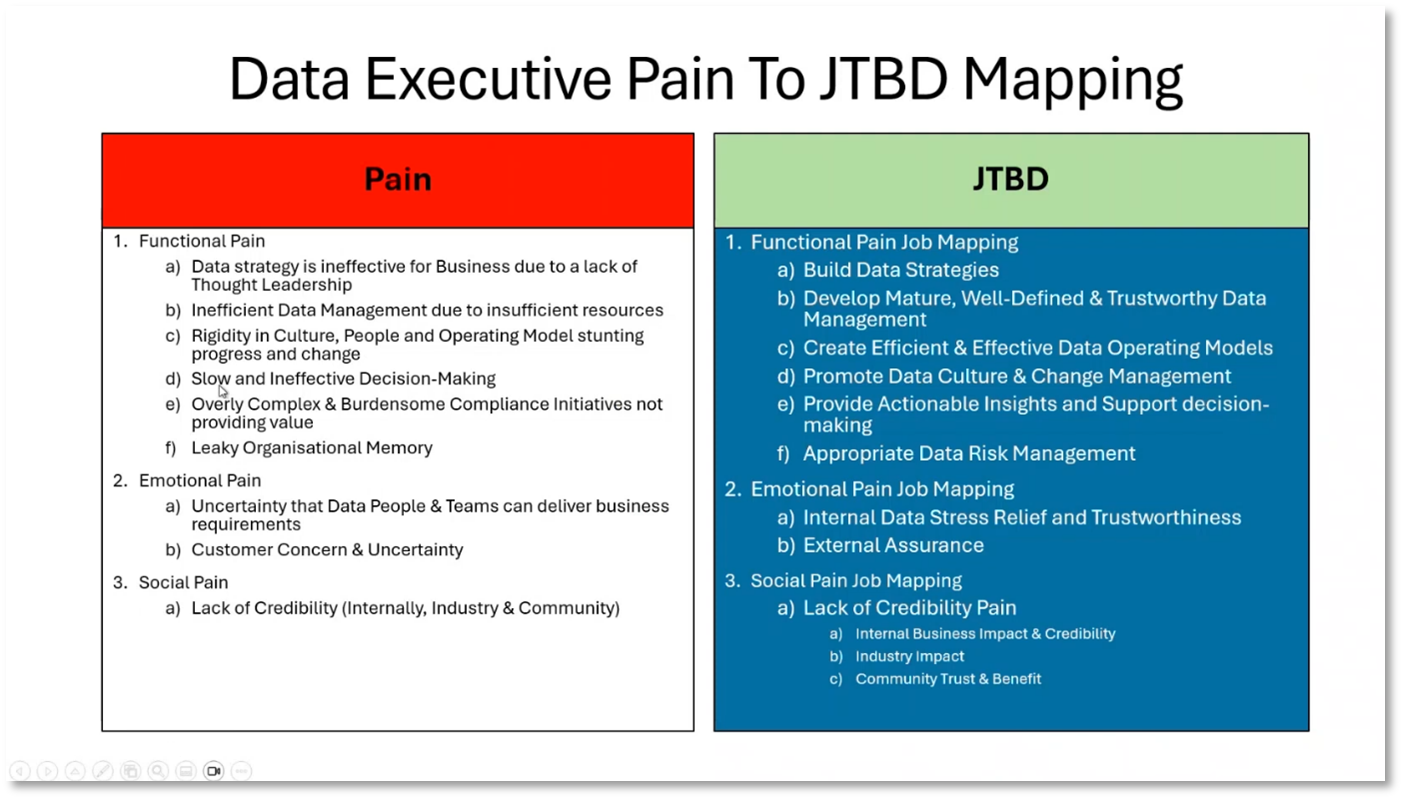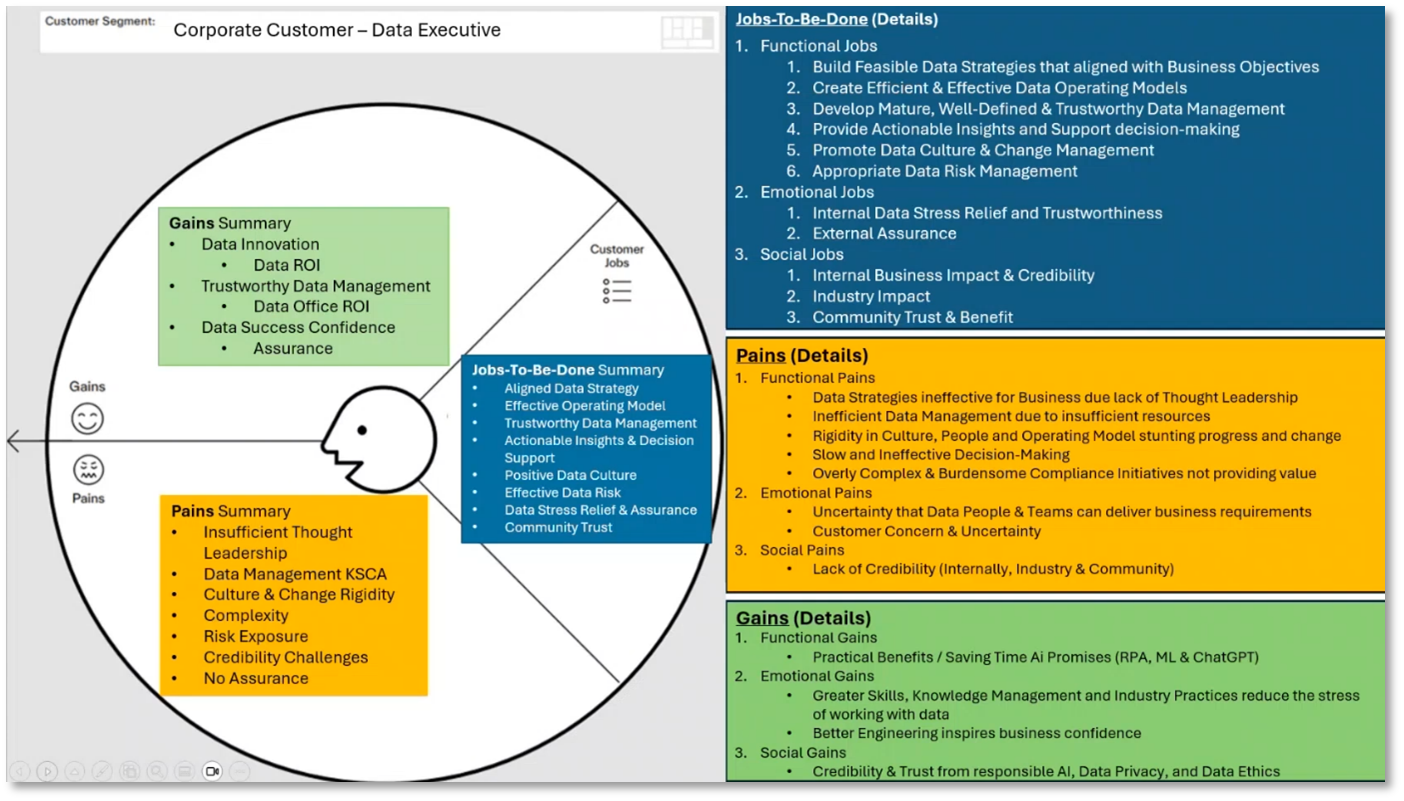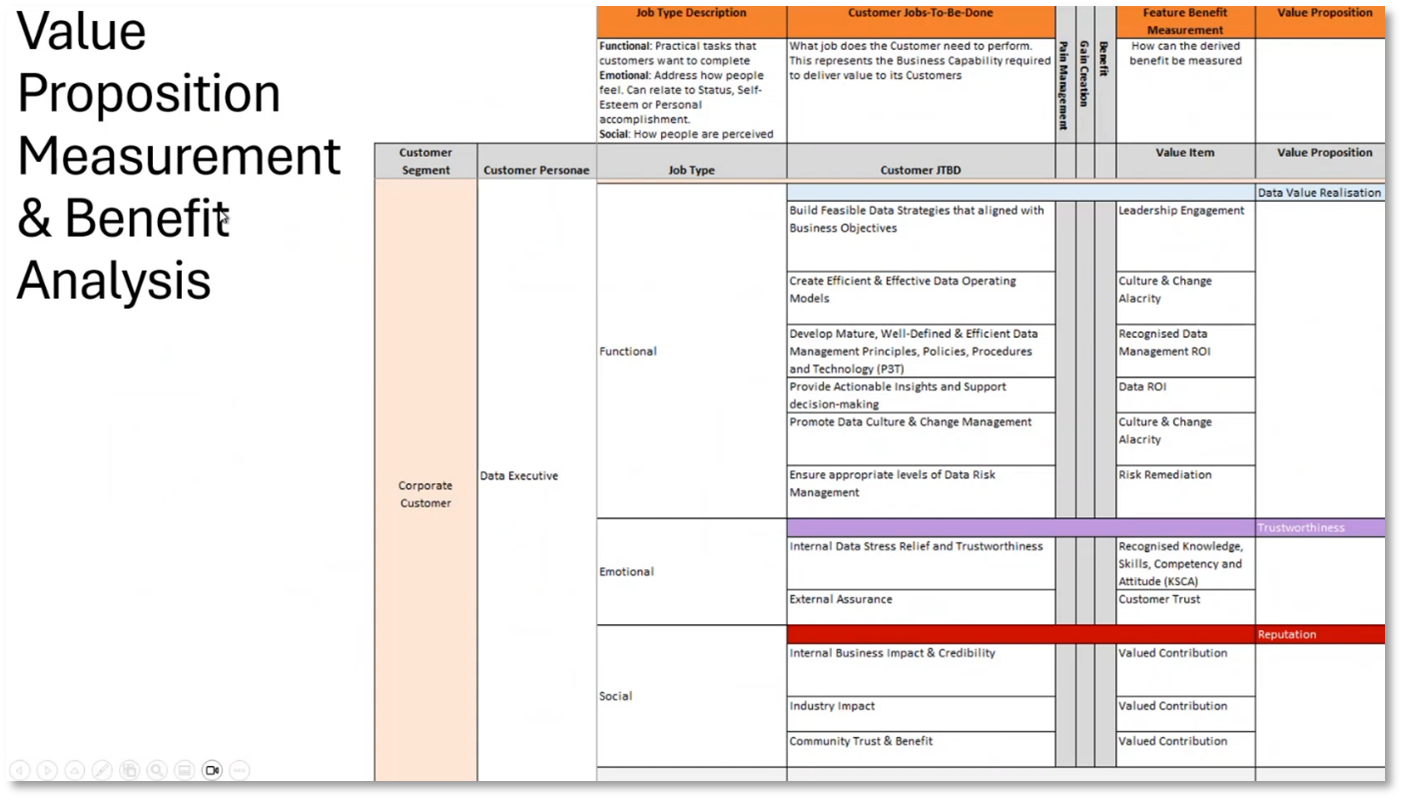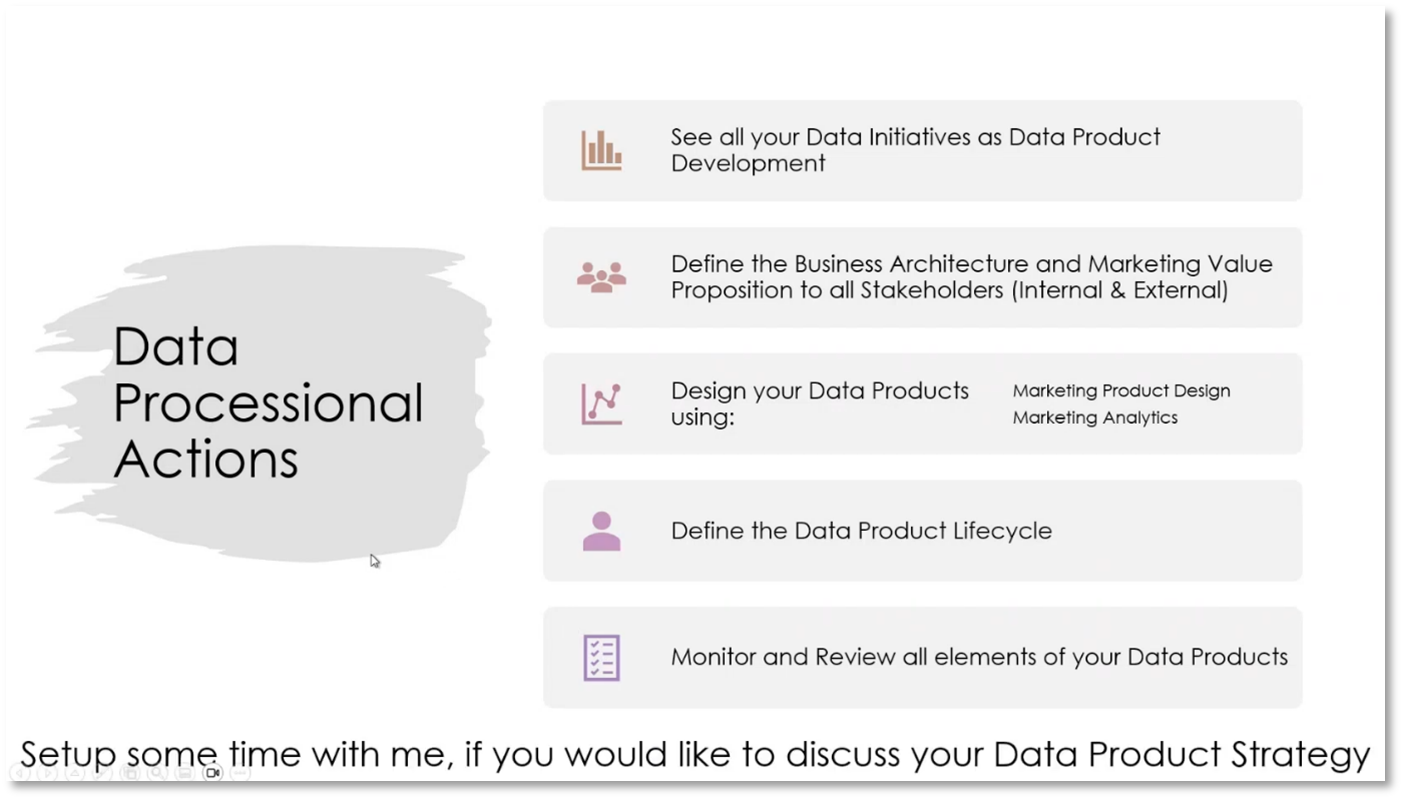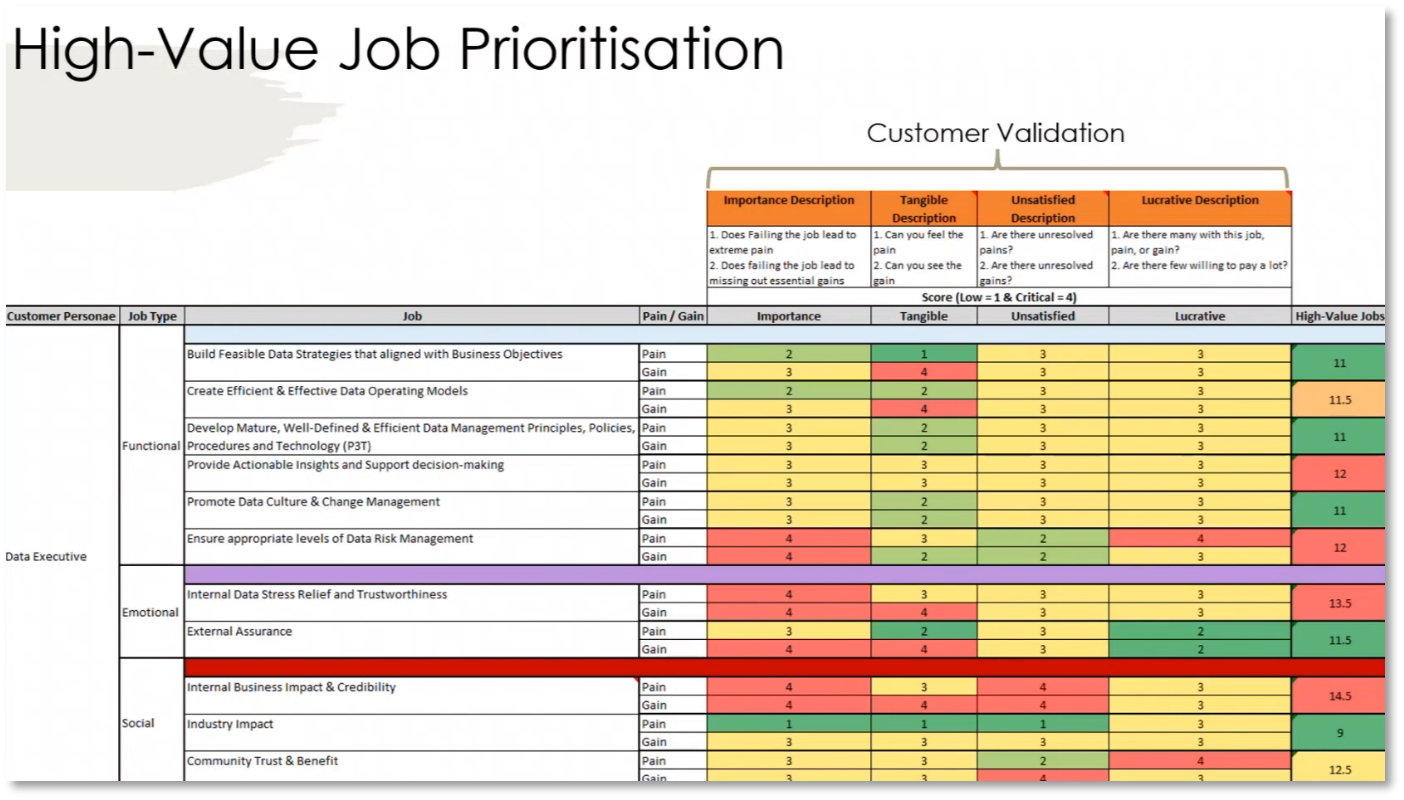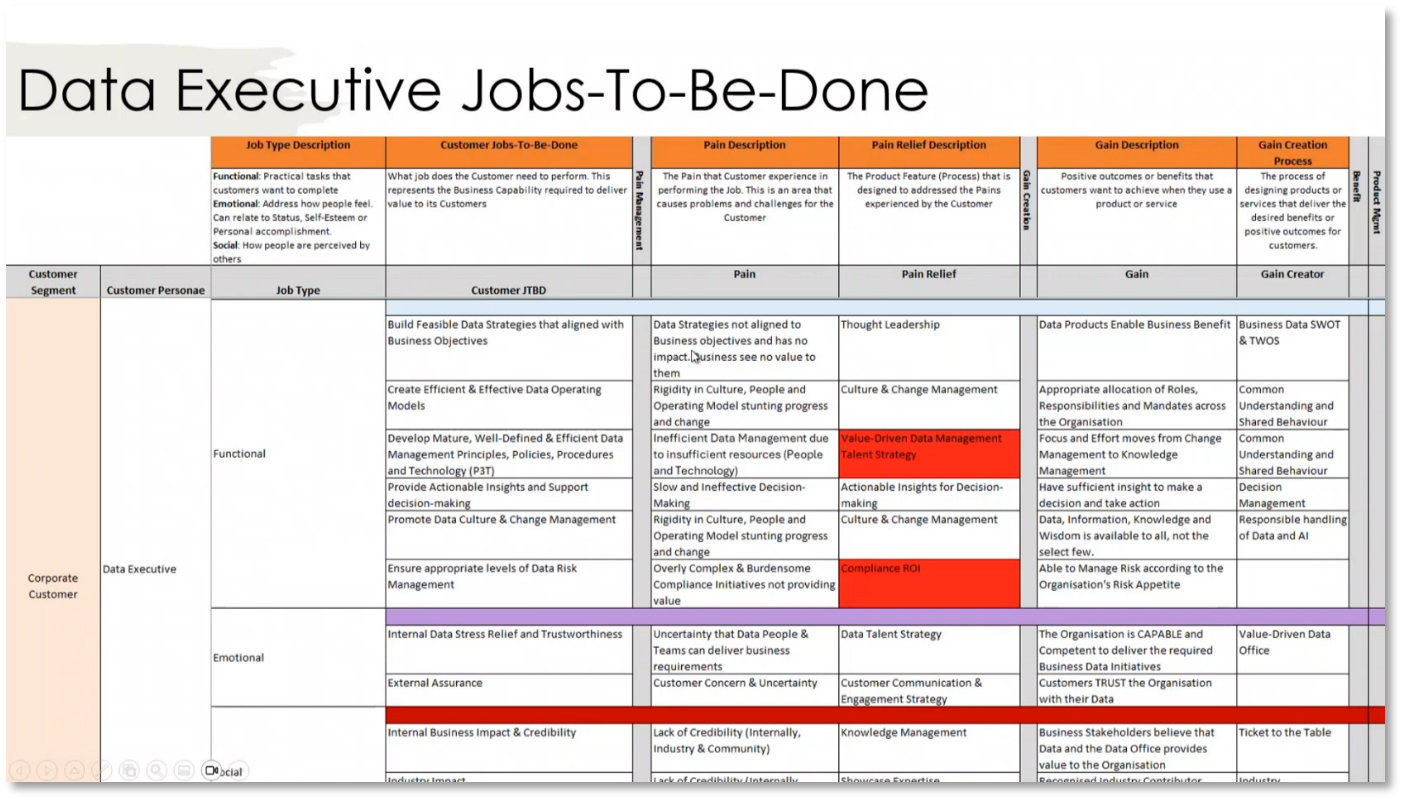Designing Data Products to Support Customer Value Proposition for Data Professionals
Executive Summary
This webinar covers critical points on Marketing Analytics and Data Product Design. Howard Diesel focuses on designing a data product, defining data products, and building and managing data products. He touches on segmentation strategies and types, data collection and analysis, utilising Qualtrics for customer segmentation, statistical analysis, and market research. There is discussion on the importance of customer segmentation in marketing, defining product features and target audience, journey map and customer profile for data executives, and developing and delivering data products. Lastly, Howard emphasises the significance of data strategy and thought leadership in business and the importance of interaction and communication within this context.
Webinar Details
Title Designing Data Products to Support Customer Value Proposition - Data Professionals
Date 24 July 2024
Presenter Howard Diesel
Meetup Group Data Professionals
Write-up Author Howard Diesel
Contents
Key Points on Marketing Analytics and Data Product Design
Designing a Data Product
Data Product Definition and Structured Definition
Data Products
Defining Data Products
Building and Managing Data Products
Segmentation Strategies and Types
Data Collection and Analysis
Utilising Qualtrics for Customer Segmentation
Statistical Analysis and Market Research
Importance of Customer Segmentation in Marketing
Defining Product Features and Target Audience
Journey Map and Customer Profile for Data Executive
Developing and Delivering Data Products
Designing Data Products and Customer Needs
Strategy Meeting Notes
Importance of Data Strategy
Importance of Data Strategy and Thought Leadership in Business
Key Points on Marketing Analytics and Data Product Design
Howard Diesel opens the webinar by stressing the significance of value propositions in business architecture and customer understanding. He encourages the audience to explore product management and design, underscoring the need for a different perspective on data products and emphasising the importance of use cases that deliver them. An attendee, Paul Bolton, offered insights into new thinking for data product design, citing a specific case involving a customer in Lesotho seeking training.
Figure 1 Designing Data Products: Customer Value Proposition Data Professional
Designing a Data Product
Howard notes a request for a one-day fundamentals course on data management, data governance, and data quality, prompting consideration of the value proposition for the course. Customer feedback will be gathered to determine the potential for adding modules and extending the course to two or three days. He emphasises the importance of understanding customer needs and pains, both for external and internal customers, in developing a value proposition. Howard notes that he will focus on designing a data product, including understanding required data and defining product features based on input from business and marketing teams. Additionally, the session will concentrate on the data profession, introducing the topic of defining a data product and its core elements, as previously discussed by Gary Alleman.
Data Product Definition and Structured Definition
The data product encompasses raw data, APIs, data services, and governance. It is defined by its curated, clean, and understandable nature, with metadata and data models, findable through data catalogues, and shareable, accessible, and reusable. Data products can be dashboards, machine learning models, recommendation engines, or APIs. Creating a structured definition involves identifying fundamental classifications, purpose and function, stakeholders, and specific product characteristics, with the ultimate goal of providing holistic insights, solving problems, and transforming data into decision-making processes for various stakeholders and business needs.
Figure 2 Data Product Platform
Figure 3 Data Product Definition
Figure 4 Writing Business Definitions
Figure 5 Data Product Definition
Figure 6 Data Product
Data Products
Data products should specify when and where they are used, and they must be created from reusable elements and presented using business intelligence tools and predictive models. Clarifying the abstract terms related to various stakeholders and solving business problems is important. There should be a discussion on whether a business glossary qualifies as a data product and whether it solves a business problem. Understanding the significance of accurately defining a data product and utilising techniques like the 5 Whys to comprehend what a data product entails is crucial. A data product must address a business problem, offer actionable insights, and facilitate decision-making. Lastly, input from an attendee on the purpose and function of a data product and its role in solving business problems and supporting decision-making is emphasised.
Defining Data Products
The definition of data products is often criticised for being too abstract and lacking specificity. It is essential to break down this definition to create a comprehensive and practical business glossary. A clear definition is crucial to avoid confusion when developing data products that address specific customer profile business problems. Designing such products requires a deep understanding of customers' challenges, pains, and gains, and conducting a SWOT analysis on the strategy can help in breaking down the use case into necessary elements. Understanding customer segments and personas is vital for designing effective data products.
Figure 7 Data Product Related Terms
Figure 8 Data Product - Completed Definition
Figure 9 Data Product - Completed Definition continued
Building and Managing Data Products
The data product should be available on demand, adhere to timeliness expectations, be internally and externally accessible, and be validated and tested internally before releasing externally. It should be constructed from multiple reusable elements, focusing on defining data products and addressing the why and who of data product management. Customer segmentation is important for understanding the needs, priorities, and interests of target markets, and building a stakeholder map is fundamental to defining customer segments, involving the division of the target market into approachable groups based on their needs, priorities, and interests.
Figure 10 Customer Segmentation Definition
Segmentation Strategies and Types
Howard highlights using customer behaviour and job roles to guide product sales and marketing strategies. He outlines various segmentation types, including demographic, firmographics, psychographic, and behavioural segmentation. The segmentation process is detailed, emphasising the importance of aligning segmentation objectives with business goals and the steps involved in data collection, analysis, and strategy development for effective targeting efforts.
Figure 11 Segmentation Types
Figure 12 Segmentation Process
Data Collection and Analysis
The data process involves collecting, cleaning, and integrating data, focusing on understanding customer demographics and distribution. Once customer profiles are identified, designing product features that align with the value proposition is crucial. Data professionals need to appreciate the complexity of handling large datasets. Conjoint analysis is a statistical method to understand customer preferences for product features and their perceived value.
Figure 13 Segmentation Process continued
Figure 14 Segmentation Data Model
Figure 15 Segmentation Analytics: Conjoint
Figure 16 Segmentation Analytics: Qualtrics
Utilising Qualtrics for Customer Segmentation
Howard shares that he is evaluating customer segmentations for Modelware Systems and exploring using the Qualtrics tool for analysis. The cost of using the tool is $1,293 a month, amounting to nearly $15,000 annually, or 100 to 200,000 rand. The objective is to identify the most influential attributes driving respondents to make decisions. Critical data elements (CDEs) within the data product can aid decision-making and validate customer preferences. Howard discusses utilising the Qualtrics tool for survey management, distribution, and data analysis. Variables such as location, distribution channel, language, and age influence the willingness to invest in a learning product. Additionally, an existing output showcases the price ratio, indicating how much extra respondents would spend on a better battery.
Figure 17 Sample Conjoint Project by Qualtrics
Figure 18 Sample Conjoint Project by Qualtrics continued
Figure 19 Segmentation Analytics: Variables
Figure 20 Describe a Variable: Battery Price Point
Statistical Analysis and Market Research
Analysis indicates that the number of hours of battery power significantly influences how much individuals are willing to spend. The analysis refutes the null hypothesis, which suggests that battery hours do not impact the amount of money people are willing to pay. Key features of a computer, such as battery life, screen on time, price, camera quality, front camera options, and biometric features, play pivotal roles in influencing product pricing and designing consumer-oriented products. The analysis underscores that consumers are willing to pay a premium for optimal battery power, with some willing to spend $1100 for 13 hours of battery life.
Figure 21 Relate 2 Variables: Battery Life & Price Point
Figure 22 Reports
Importance of Customer Segmentation in Marketing
Understanding market segments is essential for effective customer segmentation, with buyer personas helping to identify customers interested in specific features. Developing a semi-fictional representation of the target customer aids in engaging with, and understanding shared behaviours, as demonstrated in an HR product example. Effective customer segmentation involves addressing specific needs for each persona, such as addressing employee concerns and overcoming communication barriers for different personas like the VP of HR and entry-level employees.
Figure 23 HR Buyer Persona: Product - Employee Feedback
Figure 24 Product / Service Alignment
Defining Product Features and Target Audience
The product's features aim to alleviate specific pains and deliver user gains. For one of the attendees, the product should support her in achieving KPIs, ensuring task submissions, and averting negative Glassdoor reviews while fostering employee happiness. For another, the product should be user-friendly, frequently utilised, and guarantee anonymous feedback that does not serve company or HR interests. Howard notes that the goal is to align the product and service with users' needs and challenges. One approach to achieve this is using a Mirror board to categorise these elements and define the product's scope. Additionally, Howard is currently focusing on segmentation, distinguishing the selling approach between corporate and individual customers.
Figure 25 Designing Value Proposition(s) for Data Management Capability
Figure 26 Market Segments and Customer Personae
Journey Map and Customer Profile for Data Executive
The customer profile details various personas within the corporate segment, including the data team lead, data product deliverer, data management manager, and data executive. At an individual level, the personas encompass a citizen, professional, data specialist, and thought leader. The data executive plays a pivotal role in cost reduction, profit increase, data governance improvement, fraud mitigation, regulatory compliance, strategy formulation, culture building, and complex data project management. The customer profile delves into the challenges, relief strategies, and benefits of the data executive's responsibilities, aiming to showcase their expertise and credibility while delivering value-driven content.
Figure 27 Data Executive Value Proposition
Figure 28 Data Executive Pain to JTBD Mapping
Figure 29 Data Executive Pain & Relief
Figure 30 Data Executive: JTBD, Pains and Gains
Developing and Delivering Data Products
Understanding customer pain points, prioritising jobs, and creating a value proposition for data executives are essential in delivering successful data products. Validation through communication and surveys, measuring delivery benefits, and adjusting project views are crucial components of product development. Additionally, designing data products and features using marketing techniques and defining the product life cycle from minimal viable products through subsequent phases are fundamental for successful product development.
Figure 31 High-Value Job Prioritisation
Figure 32 Data Executive Jobs-To-Be-Done
Figure 33 Value Proposition Measurement & Benefit Analysis
Figure 34 Data Professional Actions
Designing Data Products and Customer Needs
The focus shifts to enhancing data products based on customer requirements, emphasising the importance of monitoring, reviewing, and strategising. Howard suggests using conjoint analysis to identify crucial features, quantifying their impact, and evaluating profitability. Furthermore, he highlights the need to address unresolved customer concerns and assess the profitability of targeting specific segments. The strategy of offering free products with ads is also mentioned to ensure the profitability of data products while emphasising the need to balance customer acquisition with profitability.
Strategy Meeting Notes
Howard mentions Spotify’s marketing approach of cross-selling and upselling opportunities, emphasising the importance of feature analysis to understand market and customer segments. Additionally, there’s a discussion about ranking and designing a survey to comprehend product features and customer needs. An attendee mentions plans to test the created ranking and conduct a survey to gather data on various variables.
Importance of Data Strategy
The key points to remember when designing a survey include understanding different questions and considerations and the importance of customer validation to confirm feature ranking. It's also crucial to recognise the need for a data strategy to address low-ranking and potential issues. This involves understanding the pains and gains that drive the need for a data strategy and the lead-in role of a data strategy in addressing other issues like stress relief and business impact. Training and awareness around linking issues to the data strategy is also important for effective implementation.
Figure 35 High-Value Job Prioritisation
Figure 36 Data Executive Jobs-To-Be-Done
Importance of Data Strategy and Thought Leadership in Business
When the business's data strategies are not aligned with its goals, this creates a perceived lack of value. To address this, thought leadership is essential to influence executives and change their mindset. Howard stresses demonstrating the benefits of a data strategy, such as identifying threats, weaknesses, opportunities, and strengths, as these can help the business recognise its value. Defining a clear process is critical to addressing complaints about inefficient data management and resource limitations, signalling the need for a roadmap. While product alignment is important, understanding feature priorities is crucial before pursuing it.
If you would like to join the discussion, please visit our community platform, the Data Professional Expedition.
Additionally, if you would like to be a guest speaker on a future webinar, kindly contact Debbie (social@modelwaresystems.com)
Don’t forget to join our exciting LinkedIn and Meetup data communities not to miss out!




